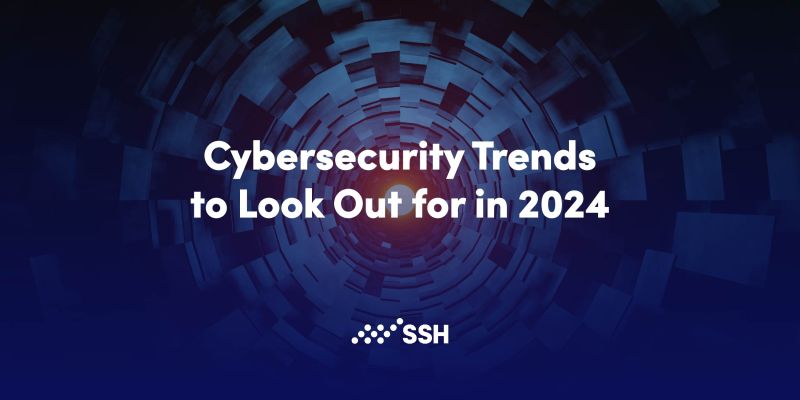
The importance of cybersecurity has been on the rise for a while now. In 2024, cybersecurity will make its way into boardrooms, enter the AI battlefield, or change how businesses juggle their trade secrets and sensitive communications.
Here are our top 8 cybersecurity trends to look out for in 2024:
Contents
1. Next-level Zero Trust
2. Identity security and management
3. Next-level secure business communications and collaboration
4. Cybersecurity regulations and compliance
5. OT and IoT cybersecurity
6. Cybersecurity insurance
7. AI and deepfake cyberattacks
8. Quantum computers and data harvesting
How to be cyber-secure in 2024
- Advancing Zero Trust
Zero Trust has become a familiar concept, but in 2024, it will redefine cybersecurity. It won’t merely focus on architecture alone. Organizations will universally adopt this architecture to eliminate perimeters and borders, ensuring every user and device—internal or external—is verified before accessing networks, systems, applications, or data, regardless of their location.
As the threat landscape evolves, so does Zero Trust. The next evolution emphasizes not just proactive measures but also holistic and adaptable approaches:
- Proactive Verification: Ensuring user and device identities are verified before accessing resources to preempt risks.
- Holistic Approach: Addressing the entire ecosystem, including diverse users (third-party vendors, partners, remote workers) and devices (BYOD, company devices, IoT), with appropriate authentication methods.
- Adaptability: Utilizing cutting-edge technologies like AI-driven real-time analysis to monitor ecosystems continuously, identify anomalies, and adjust processes automatically to mitigate risks effectively.
- Identity Security and Management
In tandem with Zero Trust, identity security will gain prominence. Businesses will deploy robust identity verification mechanisms to ensure ongoing authentication of employees, partners, vendors, and customers, crucially important given the rise of sophisticated identity-based cyberattacks.
Major tech players are also emphasizing identity-focused security, such as Microsoft’s entry into the IAM market with Entra ID. Continuous identity verification becomes imperative amid threats like AI-generated audio and video content used for identity theft.
As a result, businesses will increasingly adopt bullet-proof identity authentication methods like biometric verification, paying meticulous attention to access rights and compliance with stringent data security regulations.
- Enhanced Business Communications Security
2024 will reinforce the necessity for highly secure tools in business communications and collaboration. Organizations will move away from conventional, often non-compliant tools towards authorized, auditable, and secure collaboration platforms. These platforms will enable end-to-end encrypted messaging, secure audio/video calls for discussing sensitive business information, compliant data sharing, and digital signing of confidential documents.
This shift aims to prevent data leaks and ensure adherence to data security laws and regulations, avoiding costly breaches and regulatory penalties.
- Cybersecurity Regulations and Compliance
2024 will witness the enforcement of two pivotal cybersecurity frameworks:
- NIST Cybersecurity Framework (CSF) 2.0: Updated to reflect the evolving cybersecurity landscape, providing detailed guidance for organizations to implement robust cybersecurity measures.
- NIS2 Directive: Effective from October 17, 2024, across EU nations, mandating compliance with stringent cybersecurity standards. Non-compliance could result in fines amounting to €10,000,000 or 2% of global annual revenue.
These frameworks underscore the imperative for organizations to prioritize cybersecurity compliance to mitigate risks effectively.
- OT and IoT Cybersecurity
Industrial and critical infrastructure sectors in 2024 will prioritize OT and IoT cybersecurity amidst rising cyber threats. Increased remote access and connectivity of OT/IoT devices amplify security challenges, necessitating modernization of systems with robust security controls.
The convergence of IT and OT environments will enhance cybersecurity measures, focusing on access management and identity security across complex OT ecosystems involving employees, remote workers, third-party vendors, and partners.
- Cybersecurity Insurance
In 2024, the elevation of cybersecurity importance will see more CISOs and cybersecurity experts joining leadership teams and boards. This shift stems from heightened awareness among C-level executives about the business risks posed by inadequate cybersecurity measures.
Increased accountability, driven by regulations like the NIS2 directive, will propel organizations towards predictive and defensive cybersecurity strategies, emphasizing proactive threat prevention.
- AI and Deepfake Cyberattacks
The advent of AI-powered cyberattacks in 2024 will intensify the battle against AI-driven threat detection technologies. Cybercriminals will leverage AI to craft sophisticated attacks, including AI-generated phishing and deepfake content that evade traditional detection methods.
Conversely, AI will bolster cybersecurity defenses with predictive analytics, anomaly detection, and automated response mechanisms, fortifying organizations against evolving cyber threats targeting AI technologies.
- Quantum Computers and Data Security
Quantum computing’s advancement poses new challenges in data security. In 2024, malicious actors will intensify efforts to harvest long-term sensitive data, anticipating future decryption capabilities enabled by quantum computing.
Addressing these risks, the adoption of post-quantum cryptography (PQC) will gain traction, bolstered by upcoming NIST standards for PQC algorithms. Organizations will seek PQC solutions to safeguard sensitive data-in-transit against potential quantum-enabled decryption threats.
These insights highlight the critical cybersecurity trends and challenges shaping 2024, underscoring the imperative for organizations to adopt proactive and adaptive cybersecurity strategies to mitigate evolving risks effectively.
How to be cyber-secure in 2024
Whether these predictions make you hopeful or worried – most likely, you are curious about how to improve your cybersecurity posture for 2024 as well as the upcoming years.
We at SSH Communications Security can assist you with:
Source: https://www.ssh.com/blog/cybersecurity-trends-to-look-out-for-in-2024
About DT Asia
DT Asia began in 2007 with a clear mission to build the market entry for various pioneering IT security solutions from the US, Europe and Israel.
Today, DT Asia is a regional, value-added distributor of cybersecurity solutions providing cutting-edge technologies to key government organisations and top private sector clients including global banks and Fortune 500 companies. We have offices and partners around the Asia Pacific to better understand the markets and deliver localised solutions.










